At the time of Bharani the Full Moon should have been at Cursa
when the Sun was in "September 25:
| E vae ra - ka oho
- ki te henua - kua huki |
ku kikiu - te
henua |
32 |
|
Huki. 1. Pole attached to the
poop from which the
fishing-net is suspended: huki kupega. 2. Digging stick. 3. To
set vertically, to stand (vt.). 4. Huki á
te mahina, said of the new moon when both its
horns have become visible. Vanaga. 1. To post up, to
publish. 2. To cut the throat (uki). Mq.:
Small sticks which close up the ridge of a house.
Ha.: hui, the small uniting sticks in a
thatched house. Churchill. Standing upright.
Barthel. M. Spit for roasting. Te Huki, a
constellation. Makemson. Hukihuki. 1. Colic.
2. To transpierce, a pricking. 3. To sink to the
bottom. Churchill.
HUI¹,
v. Haw., to unite together, to mix, to add
one to another, to assemble, meet; s.
cluster, collection of things; huihui, a
bunch, cluster; huiuna (for huiana), a
seam in a garment; la-hui, collection of
people, a nation. Sa. sui, to dilute, to add
ingredients to a thing; sui, to sew, to
thread beads; susui, to mend, repair;
susuia, to fasten the ridge-pole of a house.
Tong., hui, mingle, mix, join; fufui,
a flock of birds. N. Zeal., hui, huhui,
to gather, mix, unite; ra-hui, a company;
ka-hui, a herd, a flock. Tah., hui, a
collection of persons, a company; hui-hui manu,
flock of birds; hui-tara-wa, Orion's belt.
Marqu., huhui, a bundle of taro. Sanskr.,
yu, to bind, join, mix; yuj, to join;
yuga, a yoke, a pair, a couple; yûti,
mixing; yûtha, flock of birds or beasts.
Greek, ζευγνυμι,
to join, put to, yoke up, bind, fasten;
ζευγος, a yoke of
beasts, pair, couple; ζυγον,
the yoke; ζωνη,
belt, girdle. Lat., jugum,
a yoke; jugo,
bind up, tie together; jungo,
bind, join, unite. Goth., juk,
a yoke. A.-Sax., geok,
id. Scand., ok,
id. Armen., zugel,
attach together, yoke up; zoygkh,
a couple, a pair. Pers., yûgh,
a yoke. Irish, ughaim,
harness. Welsh, jow,
yoke. Lett., jûgs,
yoke. Anc. Slav., jgo,
yoke. Bohem., gho,
id. Lith., jungas,
id. A singular coincidence of application, if it has
no nearer connection, by the Polynesian and the
Latin of this word to similar purposes, occurs in
the huhui
and hui-tarawa
of the former and
jugulæ of
the latter. In Hawaiian huhui
designates a constellation generally, but especially
that of the Pleiades; in Tahitian
hui-tarawa, lit.
the transverse or horizontal cluster, designates the
stars generally called Orion's belt, and in Latin
jugulæ
represents the very same stars in the constellation
Orion. HUI²,
v. Haw., to ache, be in pain; s.
bodily pain; niho-hui, the toothache; hui,
huihui, cold, chilly, as morning air or cold
water; hukeki, hukiki, cold, shivering
on account of wet. N. Zeal., huka, cold.
Tah., hui, hui-hui, to throb as an
artery, twitchings in the flesh. Sanskr., çuch¹,
to be afflicted, grieve; çuch²,
to be wet, fetid; çuch,
s., sorrow, grief; quære suçîma,
cold? To this Sanskr. çuch
Benfey refers the Goth.
hiufau,
to mourn, lament, and the O. H. Germ. huvo,
an owl. (Fornander) |
 |
 |
|
Cb3-1
(50) |
Cb3-2
(392 + 51 = 443) |
|
CLOSE TO THE
SUN: |
|
Dec 5
(339 = 156 + 183) |
6 |
|
'Nov 8
(312 = 339 - 27) |
9 |
|
"Sept 25 (298 = 339 -
41) |
26 |
|
CLOSE TO THE FULL
MOON: |
|
5h
(76.1)
ε
Leporis (76.0),
CURSA
= β
Eridani
(76.4),
λ Eridani (76.7)
*35.0 = *76.4 - *41.4 |
μ
Aurigae, μ Leporis (77.6) |
|
June 5
(156 = 115 + 41) |
6 |
|
'May 9 (129 = 115 + 14) |
10 |
|
Vaitu Nui 25 (115 = 230 / 2) |
26 |
|
... In view of
the almost universal prevalence of the Pleiades year
throughout the Polynesian area it is surprising to
find that in the South Island and certain parts of
the North Island of New Zealand and in the
neighboring Chatham Islands, the year began with the
new Moon after the yearly morning rising, not of the
Pleiades, but of the star Rigel in Orion ...
 |
And the Explorers had reached Easter Island 37 days later, when
the Full Moon should have been at Castor:
| manu pao i te
hau tea - kua tu |
manu rere ki
te hau tea - kua tu |
manu rere ki
te hau tea |
kiore - henua |
|
Pao. To cut off, to throw a lance.
Churchill.
Paopao, spade, shovel, rubbish, to
lacerate, to have a quarrel with. Churchill.
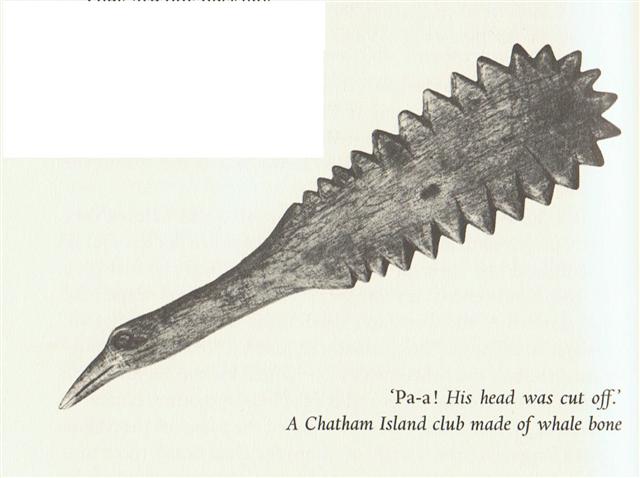
There are 27 teeth around the
tail of the bird above. |
 |
 |
 |
 |
|
Cb4-13 → 14 * 29½ |
Cb4-14 (477 = 392 + 85) |
Cb4-15 |
Cb4-16 (87 = 3 * 29) |
|
CLOSE TO THE
FULL MOON: |
| no
star listed (110) |
ALUDRA (Virgin) = η Canis Majoris
(111.1),
PROPUS = ι Gemini (111.4),
GOMEISA (Water-eyed) = β Canis Minoris
(111.6)
*70.0 = *111.4 - *41.4 |
ρ Gemini (?) (112.1),
Eskimo Nebula = NGC2392 Gemini
(112.2)
ANTARES (α Scorpii)
|
Al Dhirā'-5 (Forearm) /
Punarvasu-7 /
Mash-mashu-Mahrū-10 (Western One of the Twins)
CASTOR (Beaver)
= α Gemini
*113.4 = *41.4 + *72.0 |
|
July
9 (10 * 19) |
10
|
11
|
12
(193 = 152 + 41) |
|
'June 12 (190 - 27) |
13
(164) |
14 |
15 |
|
"May
29 (190 - 41) |
30
(150) |
31 |
Te Maro 1
(8 * 19 → 9 * 91) |
|
... The jaguar learned from
the grasshopper that the toad and the rabbit had
stolen its fire while it was out hunting, and
that they had taken it across the river. While
the jaguar was weeping at this, an anteater came
along, and the jaguar suggested that they should
have an excretory competition. The anteater,
however, appropriated the excrement containing
raw meat and made the jaguar believe that its
own excretions consisted entirely of ants. In
order to even things out, the jaguar invited the
anteater to a juggling contest, using their eyes
removed from the sockets: the anteater's eyes
fell back into place, but the jaguar's remained
hanging at the top of a tree, and so it became
blind. At the request of the anteater, the
macuco bird made the jaguar new eyes out of
water, and these allowed it to see in the dark.
Since that time the jaguar only goes out at
night. Having lost fire, it eats meat raw. It
never attacks the macuco ...'
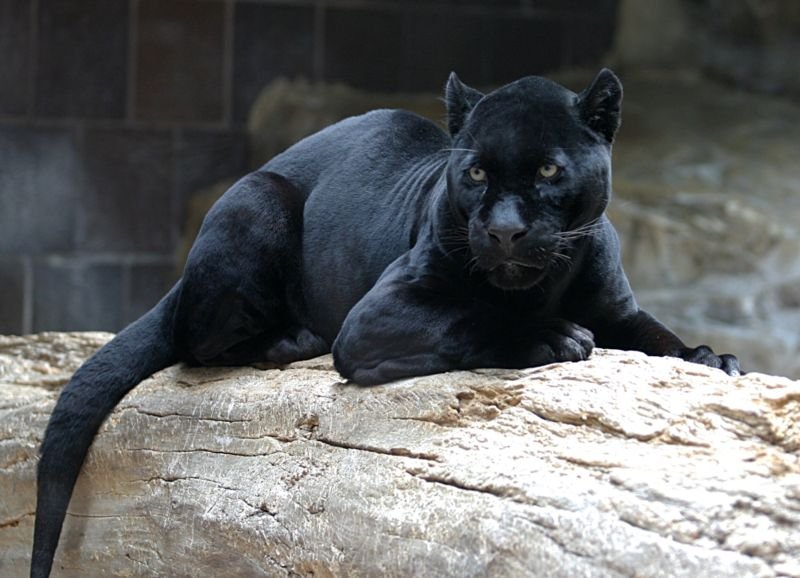 |
And
3 days later followed Pollux:
| erua
marama |
tagata noho i to mea |
kua vaha |
|
Vaha.
Hollow; opening; space between the fingers (vaha rima);
door cracks (vaha papare). Vahavaha, to
fight, to wrangle, to argue with abusive words.
Vanaga.1. Space, before T; vaha takitua,
perineum. PS Mgv.: vaha, a space, an open place.
Mq.: vaha, separated, not joined. Ta.: vaha,
an opening. Sa.: vasa, space, interval. To.:
vaha, vahaa, id. Fu.: vasa, vāsaà,
id.
Niuē: vahā. 2. Muscle, tendon; vahavaha,
id. Vahahora (vaha 1 - hora 2),
spring.
Vahatoga
(vaha 1 - toga 1), autumn. 3. Ta.:
vahavaha, to disdain, to dislike. Ha.: wahawaha,
to hate, to dislike. Churchill. |
 |
 |
 |
 |
|
Cb4-17 (392
+ 88) |
Cb4-18 |
Cb4-19 |
Cb4-20 |
|
CLOSE TO THE
SUN: |
|
Jan 12 (377) |
13 |
14 |
15 |
|
ε Sagittae (297.1), σ Aquilae (Ant.) (297.4),
SHAM
(Arrow) = α Sagittae (297.8)
*256.0 = *297.4 - *41.4 |
β Sagittae (298.0), χ Aquilae (298.3), ψ Aquilae (298.8) |
υ Aquilae (299.1),
TARAZED (Star-striking Falcon) = γ Aquilae
(299.3), δ Sagittae (299.6), π Aquilae (299.9) |
Sravana-23 (Ear or Three Footprints)
TYL =
ε
Draconis
(300.0),
ζ
Sagittae (300.1),
ALTAIR
(Flying Eagle) =
α
Aquilae
(300.3),
ο
Aquilae (300.5),
BEZEK =
η
Aquilae
(Ant.)
(300.8) |
|
CLOSE TO THE FULL
MOON: |
|
ANA-TAHUA-VAHINE-O-TOA-TE-MANAVA-7 (Pillar for elocution)
υ Gemini (114.0),
MARKAB PUPPIS = κ Puppis
(114.7), ο Gemini (114.8),
PROCYON = α Canis Minoris
(114.9) |
α Monocerotis (115.4), σ Gemini (115.7)
*74.0 = *115.4 - *41.4 |
Mash-mashu-arkū-11 (Eastern One of the Twins)
κ Gemini (116.1),
POLLUX
= β Gemini
(116.2), π Gemini (116.9) |
AZMIDISKE = ξ Puppis
(117.4)
*76.0 = *117.4 - *41.4 |
|
July 13 |
14 |
15 |
16 (197) |
|
'June 16 |
17 |
18 |
19 (170) |
|
2 |
3 |
Te Maro 4
(5 * 31) → 18 * 29½ |
5 (156) |
... In Hindu legend there was a mother
goddess called Aditi, who had seven offspring. She is
called 'Mother of the Gods'. Aditi, whose name means
'free, unbounded, infinity' was assigned in the ancient lists of
constellations as the regent of the asterism Punarvasu.
Punarvasu is dual in form and means 'The Doublegood
Pair'. The singular form of this noun is used to refer to the
star Pollux. It is not difficult to surmise that the other
member of the Doublegood Pair was Castor. Then the constellation
Punarvasu is quite equivalent to our Gemini, the Twins.
In far antiquity (5800 B.C.) the spring equinoctial point was
predicted by the heliacal rising of the Twins (see fig. 6.6). By
4700 B.C. the equinox lay squarely
in Gemini (fig. 6.7).
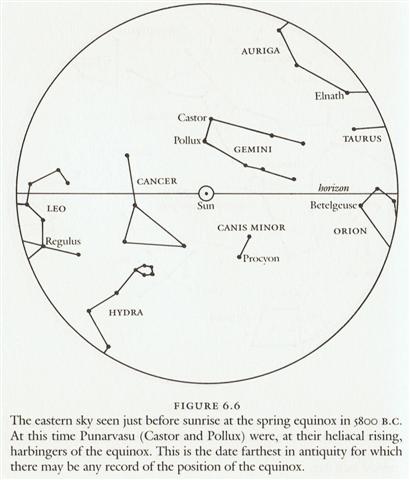
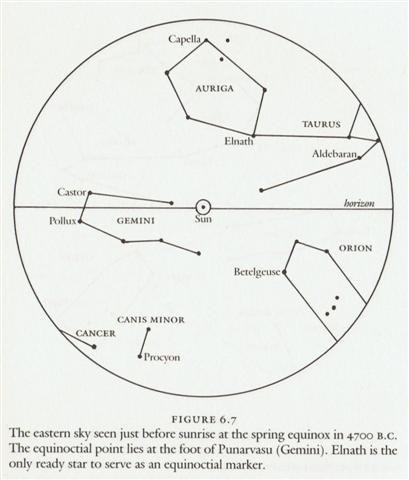
Punarvasu is
one of the twenty-seven (or twenty-eight) zodiacal
constellations in the Indian system of Nakshatras. In
each of the Nakshatras there is a 'yoga', a key
star that marks a station taken by the moon in its monthly
(twenty-seven- or twenty-eight-day course) through the stars.
(The sidereal period of the moon, twenty-seven days and a
fraction, should be distinguished from the synodic, or
phase-shift period of 29.5 days, which is the ultimate
antecedent of our month.) ...
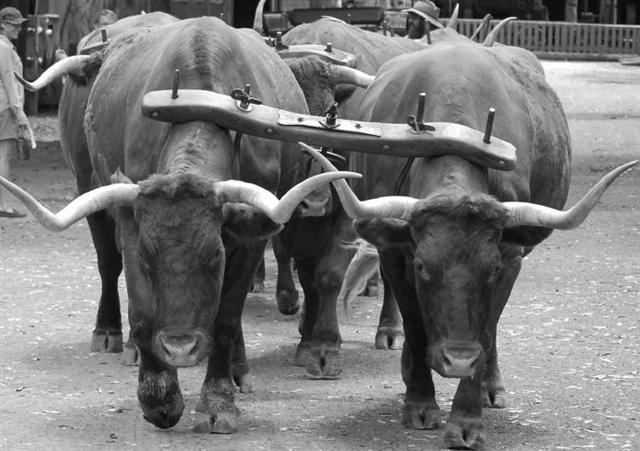
|












